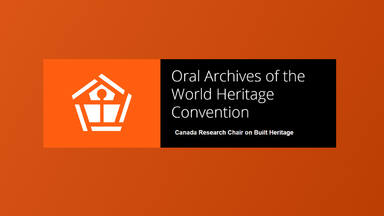Interview
Michel Olyff
1927-2023
World Heritage Convention
Designer, engraver and graphic artist, Michel Olyff created dozens of logos, emblems, posters, lithographs, stamps and other arts.
Born in 1927 and died in 2023, he studied book illustration with the Institute of Decorative Arts of La Cambre in Brussels. He started his professional life in 1956 when he was asked to design a logo for the local library. He was connected to the activities of the Cobra group and also taught for many years as a professor in the graphic arts. Committed to defending a profession which did not yet really have a name, he became a member of the International Graphical Alliance in 1966.
His first successful UNESCO project was his design for the emblem of the 1972 International Book Year. His pictographic analysis of how to represent a book offers an interesting glimpse into the mind of the graphic artist. In 1977 UNESCO contracted with Michel Olyff to produce an emblem for the World Heritage program. To capture the universal concept of World Heritage, Olyff envisages a simple design that combines a central square to represent forms created by people with a circular form that represents nature to show interdependence of humankind and nature. Despite late additions of the words “World Heritage” and linkage with the UNESCO logo, the emblem designed by Michel Olyff has remained the official World Heritage emblem ever since.
Interview with
Michel Olyff
14 December 2020
Bruxelles, Belgique
The following audio clips are from an interview with Michel Olyff by Robbert Casier and Nicole Gesché-Koning on 14 December 2020 near Brussels, Belgium. The designer reflects on the origins of his design for the World Heritage emblem and shares his reactions to some of its applications in different regions of the world.
- 1. Origin of design concepts for the World Heritage emblem
- 1a. Working methods of Michel Olyff
- 1b. Comparison with the universal peace symbol
- 1c. Influence of Gilles Fiesmann
- 2. Reaction to applications of the World Heritage Emblem
- 2.a Reaction to graphic designs
- 2.b Addition of languages to original design
- 2.c. Patrimonito
- 2.d. Negative reaction to three-dimensional monuments of the emblem
Oral Archives of the
World Heritage Convention
Under the leadership of the Canada Research Chair on Built Heritage at the University of Montreal, an international team of researchers conducts interviews with pioneers of World Heritage to capture memories of important moments in the history of UNESCO Convention.
Launched in 2006, this initiative is part of the UNESCO History project that celebrated the 60th anniversary of the creation of UNESCO. The Oral Archives project records the precious witness of people closely associated with the creation and implementation of the Convention. Their recollections and views have greatly enriched the book by Christina Cameron and Mechtild Rössler, Many Voices, One Vision: The Early Years of the World Heritage Convention (Ashgate/Routledge, 2013).
